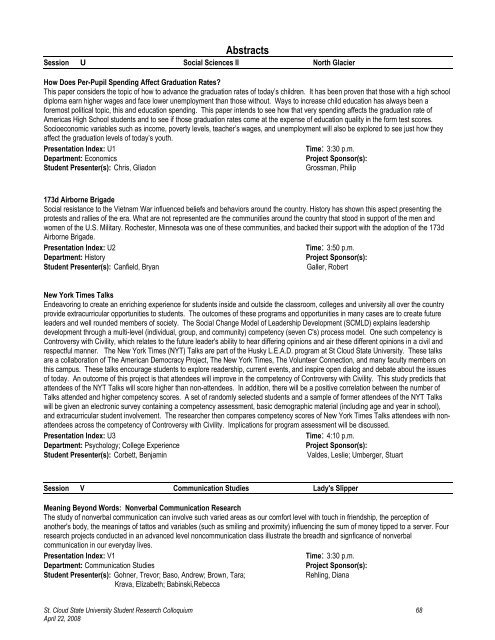2008 Proceedings - St. Cloud State University
2008 Proceedings - St. Cloud State University
2008 Proceedings - St. Cloud State University
Create successful ePaper yourself
Turn your PDF publications into a flip-book with our unique Google optimized e-Paper software.
Abstracts<br />
Session U Social Sciences II North Glacier<br />
How Does Per-Pupil Spending Affect Graduation Rates?<br />
This paper considers the topic of how to advance the graduation rates of today‘s children. It has been proven that those with a high school<br />
diploma earn higher wages and face lower unemployment than those without. Ways to increase child education has always been a<br />
foremost political topic, this and education spending. This paper intends to see how that very spending affects the graduation rate of<br />
Americas High School students and to see if those graduation rates come at the expense of education quality in the form test scores.<br />
Socioeconomic variables such as income, poverty levels, teacher‘s wages, and unemployment will also be explored to see just how they<br />
affect the graduation levels of today‘s youth.<br />
Presentation Index: U1<br />
Time: 3:30 p.m.<br />
Department: Economics<br />
Project Sponsor(s):<br />
<strong>St</strong>udent Presenter(s): Chris, Gliadon<br />
Grossman, Philip<br />
173d Airborne Brigade<br />
Social resistance to the Vietnam War influenced beliefs and behaviors around the country. History has shown this aspect presenting the<br />
protests and rallies of the era. What are not represented are the communities around the country that stood in support of the men and<br />
women of the U.S. Military. Rochester, Minnesota was one of these communities, and backed their support with the adoption of the 173d<br />
Airborne Brigade.<br />
Presentation Index: U2<br />
Time: 3:50 p.m.<br />
Department: History<br />
Project Sponsor(s):<br />
<strong>St</strong>udent Presenter(s): Canfield, Bryan<br />
Galler, Robert<br />
New York Times Talks<br />
Endeavoring to create an enriching experience for students inside and outside the classroom, colleges and university all over the country<br />
provide extracurricular opportunities to students. The outcomes of these programs and opportunities in many cases are to create future<br />
leaders and well rounded members of society. The Social Change Model of Leadership Development (SCMLD) explains leadership<br />
development through a multi-level (individual, group, and community) competency (seven C's) process model. One such competency is<br />
Controversy with Civility, which relates to the future leader's ability to hear differing opinions and air these different opinions in a civil and<br />
respectful manner. The New York Times (NYT) Talks are part of the Husky L.E.A.D. program at <strong>St</strong> <strong>Cloud</strong> <strong>St</strong>ate <strong>University</strong>. These talks<br />
are a collaboration of The American Democracy Project, The New York Times, The Volunteer Connection, and many faculty members on<br />
this campus. These talks encourage students to explore readership, current events, and inspire open dialog and debate about the issues<br />
of today. An outcome of this project is that attendees will improve in the competency of Controversy with Civility. This study predicts that<br />
attendees of the NYT Talks will score higher than non-attendees. In addition, there will be a positive correlation between the number of<br />
Talks attended and higher competency scores. A set of randomly selected students and a sample of former attendees of the NYT Talks<br />
will be given an electronic survey containing a competency assessment, basic demographic material (including age and year in school),<br />
and extracurricular student involvement. The researcher then compares competency scores of New York Times Talks attendees with nonattendees<br />
across the competency of Controversy with Civility. Implications for program assessment will be discussed.<br />
Presentation Index: U3<br />
Time: 4:10 p.m.<br />
Department: Psychology; College Experience<br />
Project Sponsor(s):<br />
<strong>St</strong>udent Presenter(s): Corbett, Benjamin<br />
Valdes, Leslie; Umberger, <strong>St</strong>uart<br />
Session V Communication <strong>St</strong>udies Lady's Slipper<br />
Meaning Beyond Words: Nonverbal Communication Research<br />
The study of nonverbal communication can involve such varied areas as our comfort level with touch in friendship, the perception of<br />
another's body, the meanings of tattos and variables (such as smiling and proximity) influencing the sum of money tipped to a server. Four<br />
research projects conducted in an advanced level noncommunication class illustrate the breadth and signficance of nonverbal<br />
communication in our everyday lives.<br />
Presentation Index: V1<br />
Time: 3:30 p.m.<br />
Department: Communication <strong>St</strong>udies<br />
Project Sponsor(s):<br />
<strong>St</strong>udent Presenter(s): Gohner, Trevor; Baso, Andrew; Brown, Tara;<br />
Rehling, Diana<br />
Krava, Elizabeth; Babinski,Rebecca<br />
<strong>St</strong>. <strong>Cloud</strong> <strong>St</strong>ate <strong>University</strong> <strong>St</strong>udent Research Colloquium 68<br />
April 22, <strong>2008</strong>
















